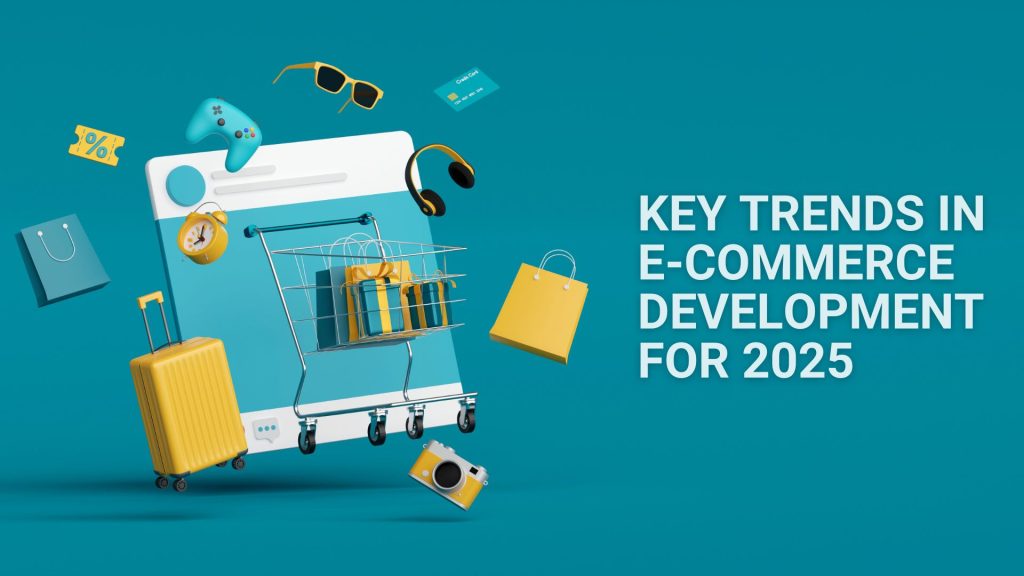
Aug 2025
Key Trends in E-Commerce Development for 2025
Sometimes, keeping up with e-commerce trends feels a bit like trying to grab a fistful of water always moving, always slipping through your fingers. But pause for a minute, take a real look, and you’ll spot some unmistakable currents driving how people shop, and everyone from nimble startups to the big e-commerce titans, are steering toward new realities. Here’s a deep (and honest) dive into what’s actually going to matter in 2025. AI Is Not Just a Buzzword, It’s the Backbone Now AI-driven personalization isn’t a "nice-to-have" anymore; it’s the expectation. Consumers scroll and swipe through so much noise, only stopping for sites that seem to understand them personally, like curated product collections, timely nudges, and offers that actually make sense based on how each shopper behaves. Brands are now leveraging machine learning far beyond recommendations: anticipating needs, detecting fraud, and tweaking marketing in real-time, all while making each visitor feel individually seen. And it’s not just the shopping journey. AI assistants are powering smarter, faster customer support, and enhancing product data accuracy faster than entire teams ever could. Augmented Reality and Virtual Try-Ons: No More Imagination Required 2025 is prime time for "try-before-you-buy," but you won’t need a fitting room, just your phone. AR and VR aren’t science fiction anymore; they’re a purchase-driver. Imagine plopping a new sofa into your living room virtually or seeing how those neon sneakers actually look on your digital feet. Brands adopting AR fuel more meaningful engagement, fewer returns, and fewer shoppers abandoning carts due to uncertainty. IKEA, Sephora, and dozens more are proving that interactive product demos and virtual try-ons are the new standard for online experiences that convert. E-Commerce on Social Media: Shopping Where the Scroll Never Stops Instagram, TikTok, and Pinterest have become digital malls. Social shopping is booming, people want discovery, recommendations, and impulse buys without ever leaving the app. Social proof is king: influencer reviews and user-generated content convert at rates most banner ads never dreamed of. In 2025, live shopping events, shoppable posts, and authentic micro-influencer campaigns are must-haves, not fads. Businesses not tapping into these buzzing ecosystems risk missing the next wave of customers and massive growth potential for business listing platforms and online directories living at the intersection of commerce and discovery. Seamless Mobile-First Experiences Let’s be blunt: If your e-commerce site isn’t flawless on mobile in 2025, you’re invisible to half (or more) of your potential market. Mobile makes up the majority of e-commerce traffic and sales. Progressive web apps, frictionless mobile checkouts, digital wallets, and even regional payment options are now non-negotiable. If you’re still asking users to pinch-and-zoom or manually type shipping details, expect bounce rates to climb and conversions to tank. Voice Search and Zero-Click Commerce: Typing Optional "Hey, find me a midnight blue blazer under $100." That’s a new reality for shoppers who want streamlined paths from inspiration to purchase. With voice assistants and conversational commerce pushing into mainstream e-commerce, expect product discovery and purchasing to be less about typing and more about talking and commands that require zero clicks at all. Brands optimizing their catalogs and search for voice stand to win the next round of lightning-fast sales. Omnichannel or Bust: Blending Digital and Physical Today’s consumers bounce between channels, online, offline, social, mobile, click, brick. They expect a "phygital" experience that’s seamless. Buy online, pick up in store. Return via locker. Use an app for personalized offers while browsing the aisles. Unified commerce is table stakes in 2025, integrating inventory, analytics, and customer data to actually deliver on "meet customers wherever they are." For small businesses, leveraging modern online directories and business listing platforms bridges local and global markets, blending visibility and convenience like never before. The Green Shift Eco-conscious buyers are choosing brands that walk the talk. Whether it’s carbon-neutral delivery, honest supply chain transparency, eco-friendly packaging, or resale marketplaces, sustainable e-commerce isn’t a marketing gimmick; it’s fast becoming the default expectation. Demand for circular business models, transparent sourcing, and traceable products is a powerful force driving platform decisions and brand roadmaps, even regulatory rules are catching up. For businesses, that means "going green" doesn’t just sound nice, it directly impacts loyalty, sales, and long-term viability. Marketplaces and Directories: The All-in-One Shopping Experience Online marketplaces continue to gobble up market share, simply because they make buying and selling frictionless. Consumers love the big selection, verified reviews, and all-in-one checkout, while sellers get access to new audiences without the headache of standalone infrastructure. Platforms like Rightfirms, which curate and connect vetted businesses for specific needs, ride this trend by making it easier for buyers and sellers to find, compare, and transact confidently. Smarter Payments and Security Drive Trust No one wants to think twice about payment security. Fast one-click checkouts, a buffet of digital wallet options, buy-now-pay-later plans, and top-tier encryption are now baseline expectations for modern e-commerce shops. As regions develop their own payment preferences, businesses need to adapt quickly or risk losing impatient customers to faster-moving competitors. Wrapping Up: Underneath all the tech, the algorithms, and the shiny new features, it’s about trust and relevance. Consumers want to buy from brands and platforms that "get" them, showing up at the right time, with the right experience, and delivering genuine value every single interaction. That means for any e-commerce business, from emerging startups to established platforms like Rightfirms, staying ahead in 2025 isn’t about copying last year’s playbook. It’s about weaving together humanity and high-tech, because in the end, the brands and business directories that win are the ones people remember, trust, and return to even as the trends keep shifting.

Feb 2025
Why do 80% of e-commerce startups fail in the first year?
E-commerce is flourishing in its turn, with world online sales reaching an estimated $8.1 trillion by 2026. At the same time, though there is so much potential, almost 80% of e-commerce businesses go bust in their first year. While the success stories of companies such as Amazon, Shopify, and Alibaba dominate the headlines, the reality for most new ventures is less than glamorous. So, why do most e-commerce startups struggle to survive? This blog will uncover the most significant challenges that lead to failure and how partnering with top-rated e-commerce development companies can make a difference. 1. Poor Market Research & Lack of Product Demand Most entrepreneurs enter the e-commerce arena without checking their business concept. Just because something is popular does not mean there is a long-term demand for it. What Goes Wrong? Selling products that lack long-term market demand. Not recognizing the appropriate target audience. Failure to analyze competitors and market trends. Top Companies Conduct thorough market research using tools like Google Trends, SEMrush, and competitor analysis to understand product viability before launching. 2. Ineffective Website Design & Poor User Experience (UX) Your website is the foundation of your online business. Your customers will leave and never return if it's slow, complicated, or complex. Common Problems: Unresponsive design (not mobile-friendly). Slow page load times. Complex checkout procedures result in cart abandonment. You can partner with experienced e-commerce website development firms specialising in platforms such as Shopify, WooCommerce, Magento, and BigCommerce to develop a fast, responsive, and conversion-driven store. 3. Poor Digital Marketing & Weak Branding Even if you have the best product, nobody will purchase it if they are unaware. Most startups collapse as a result of poor branding and poor marketing strategies. Marketing Failures: Ignoring SEO, paid advertising, and email marketing. Failure to utilize social media to engage with the audience. Dependence on paid advertising alone and neglecting organic traffic development. You can also optimise your website with SEO-focused content. Utilize social media, influencer marketing, and retargeting advertisements. Leverage email marketing to generate leads and foster long-term customer relationships. 4. Pricing & Profitability Issues Most e-commerce businesses have poor profit margins due to inappropriate pricing models. Pricing too high sends customers away, but pricing too low results in losses. Pricing Mistakes: Failing to include cost elements such as shipping, advertising, and transaction fees. Overdiscounting results in feasible revenue streams. You can implement competitive pricing models informed by market intelligence and collaborate with e-commerce agencies or consultants to price goods for the highest profitability. 5. Poor Inventory & Supply Chain Management One of the biggest reasons startups fail is inventory mismanagement. Running out of stock or dealing with long delivery times leads to frustrated customers and negative reviews. Common Mistakes: Overstocking or understocking inventory. Partnering with unreliable suppliers. High return rates due to poor product quality. Inventory management software like Shopify’s built-in tools, Zoho Inventory, or TradeGecko can be used to improve. Choose reliable fulfillment partners like Amazon FBA, ShipBob, or third-party logistics providers. 6. Ignoring Mobile Commerce & Omnichannel Strategy Inventory mismanagement is one of the most significant reasons startups fail. Out-of-stock or long delivery times result in unhappy customers and bad reviews. Common Mistakes: Stocking too much or too little inventory. Working with poor suppliers. High return rates because of low product quality. To improve these common mistakes, inventory management software such as Shopify's native tools, Zoho Inventory, or TradeGecko should be implemented. Select solid fulfilment partners like Amazon FBA, ShipBob, or third-party logistics companies. 7. Poor Customer Service & Lack of Trust Poor customer service kills companies. Customers who cannot get your assistance will look for a competitor. Common Service Problems: Long response times to client requests. There is no transparent refund/return policy. Inadequate management of negative feedback. To solve these problems better, you can implement AI chatbots for real-time customer support and provide a transparent refund and return policy. Show customer feedback, trust badges, and secure payment options to gain credibility for your services. 8. Not Partnering with Reputed E-Commerce Companies One of the most common errors e-commerce startups make is attempting everything in-house rather than collaborating with experienced e-commerce development companies. Why Work with Experts? Expert e-commerce agencies assist with site creation, design, and search engine optimisation. Marketing agencies ensure your store reaches the right audience. Tech support teams assist with troubleshooting problems such as website crashes or security issues. RightFirms brings you in touch with highly-rated e-commerce service providers to assist you in establishing, promoting, and growing your business effectively. Final Thoughts: How to Ensure E-Commerce Success? Though 80% of startups fail, the other 20% succeed due to: Carrying out adequate market research. Collaborating with the best e-commerce development firms. Spending on SEO, marketing, and branding. Providing excellent user experience and customer support. Controlling inventory and pricing. To avoid pitfalls and establish a successful e-commerce business, collaborate with reliable e-commerce professionals listed on RightFirms. Get the Best E-Commerce Development & Marketing Experts Today.

Feb 2025
Top 10 E-Commerce Tools to Boost Your Online Business
In the fast-moving digital marketplace, running an effective online business means more than having a user-friendly website and several great products. To stay ahead in the game, it is essential to use the appropriate e-commerce development tools, which help simplify processes, improve customer experiences, and advance e-commerce growth. This blog will explore the top 10 business tools for e-commerce, which will propel your online store to performance maximisation and increase profit. 1. Shopify – The All-in-One E-Commerce Platform Shopify is a top contender in e-commerce development. This powerful platform offers everything you need to set up, run, and grow your online store. Shopify ensures your store is functional and visually appealing with customisable themes, integrated payment gateways, and seamless mobile optimisation. Key Features: Easy product management Built-in SEO tools for online store optimisation 24/7 customer support Whether you are a small business or a growing brand, Shopify adapts to your needs and empowers you to scale effortlessly. 2. WooCommerce – Flexible E-Commerce for WordPress Users If you already use WordPress for your website, WooCommerce is the ideal solution for adding e-commerce growth capabilities. This plugin transforms your WordPress site into a fully functional online store, offering flexibility and scalability for businesses of all sizes. Key Features: Open-source platform with extensive customisation Hundreds of free and paid extensions Integration with popular digital sales tools WooCommerce is perfect for businesses that want complete control over their store’s design and functionality. 3. BigCommerce – Enterprise-Level Functionality BigCommerce is a comprehensive platform for businesses seeking massive growth in e-commerce. It is ideal for enterprises expanding into the international market as it is highly scalable, secure, and robust. The significant highlights include: Multi-channel selling through Amazon and eBay Crystalline analytics and reports The checkout experience can also be customised BigCommerce allows you to focus on scaling up your business while letting the platform handle technical complexities. 4. Klaviyo – Powerful Email Marketing for E-Commerce Email marketing is a pillar of any successful e-commerce strategy and the one area in which iteration occurs. This tool excels at crafting hyper-personalized email campaigns that earn engagement and drive conversions. Key Features: Behavior-based automation Advanced segmentation for targeting and precision marketing Analytics to measure campaign performance Integrating Klaviyo into your online store will turn your email marketing into a moneymaker. 5. Semrush – Optimize Your Online Presence A well-optimized online store is key to organic traffic and long-term success. Semrush is a versatile tool that helps you research keywords, analyse competitors, optimise content for better search engine rankings, and more. Major features are Comprehensive SEO audits Insights into the competitor's strategy Content marketing and backlink analysis A web tool like Semrush helps ensure your website stands ahead in the big e-commerce competition landscape. 6. Stripe – Simplified Payment Processing Stripe is the best solution for smooth transaction processing while maintaining the highest levels of security in online store optimisation. It can be used for multi-currency payments and multiple payment methods, which is helpful for a business that reaches various parts of the world. Major Features Easy integration with e-commerce Fraud prevention tools Detailed analytics about payments Stripe improves customer experience by having hassle-free, secure checkout. 7. HubSpot – CRM for E-Commerce Businesses This stands out as one of the most valuable business tools for e-commerce. It enables features that streamline customer relationship management, benefiting businesses that want to enhance customer engagement and retention. Key Features Unified customer data for personalised experiences Integration with popular digital sales tools Analytics to track customer journeys With HubSpot, you can create meaningful connections with your customers, driving e-commerce growth. 8. ShipStation – Streamline Your Shipping Process Fast and efficient shipping is essential for customer satisfaction. ShipStation simplifies order fulfilment by integrating with your e-commerce platform and smoothing shipping. Key Features: Multiple carriers are supported, such as FedEx and USPS Automated tracking updates for the customers ShipStation offers discounted rates for shipping ShipStation will help you save time and money while amazingly delighting your customers by automating your shipping operations. 9. Canva – Create Stunning Visuals Visual content helps attract customers to your store and gives a glimpse into the products on sale. Canva's design platform enables users to produce impressive graphics for their websites, social media, or email marketing. Key Features User-friendly interface Drag-and-drop feature More than a thousand templates Helpful tools to make product images, banners, and ads. Elevate your branding through Canva: no professional skills are required to change the look and feel of your store. 10. Hotjar – Gain Insights into Customer Behavior Hotjar offers the necessary data to analyse your online store and customers' interactions with your website. This tool uses heat maps and session recordings to analyse user behaviour. Its key features are: Visual view of customer activity Feedback tools that help in gathering insights Conversion funnel tracking Hotjar empowers you to identify pain points in your customer journey and make improvements that drive conversions. Why These Tools Are Essential for E-Commerce Growth? Each tool addresses a different aspect of running an effective online business, from website development and payment processing to marketing and customer engagement. Integrate these e-commerce business tools into your strategy for online store optimisation, improved customer experience, and other opportunities for further growth in the e-commerce domain. Final Thoughts Running an online business constantly demands adapting and innovating. The right digital sales tools simplify your operations and help you gain the competitive edge you need to thrive in today's crowded market. Whether you are a beginner or looking to scale, all the above tools help streamline your processes, engage your audience, and boost your sales.

Oct 2024
E-Commerce Development Strategies to Boost Online Sales
E-Commerce Development Strategies to Boost Online Sales With the highly competitive nature of the marketplace in today's digital world, a sound strategy towards e-commerce development is one of the most crucial elements for building and giving a boom to online sales. Since businesses tend to expand and go online, they are in that critical point in taking up some serious and robust e-commerce solutions that do not attract just a customer but keep him engaged for a repeat purchase. No matter whether you just begin a web store or strive to improve your existing one, effective strategies can significantly affect sales performance. Here is an elementary guide with some of the leading e-commerce strategies to enhance sales and propel your business. 1. User-Centric Website Design To make all visitors go from being visitors to becoming customers, the design of your e-commerce site has a critical function. A clean site and easy navigation improve user experience, making all the difference in retaining potential buyers. Invest in the development of an e-commerce version that is designed for optimization of your layout, speed, and functionality. Responsive Design: The website needs to be responsive as most customers browse and shop through their mobile devices. Easy Navigation: The navigation should be easy to navigate. When the products are categorized, and there is a search bar, it simplifies the efforts to locate whatever a customer might need, which in turn increases the chances of sale. 2. Optimized Product Pages The product pages have to deliver a smooth shopping experience. High-quality images, product descriptions, and user reviews- all contribute to convincing prospects to make a purchase. Here are some e-commerce solutions that shall further enhance the sales of your products: Product Images: Include high-resolution images with various views of a product. Zoom features, along with 360-degree views, will definitely give the customer a better feel for the product. Compelling Descriptions: Craft short, engaging, informative, and expressive descriptions that emphasize the best features and benefits the product can offer customers and create value for customers. Customer reviews: Positive feedback and reviews develop trust. Allow customers to comment on products quickly and ensure reviews appear right on the product page. 3. Personalized User Experience Personalization is a tremendous e-commerce strategy that boosts customers' engagement and sales potential. Personalized marketing strategies allow tailored shopping experiences for individual customers. Personalized Suggestions: Leverage data about customers to return personalized product suggestions based on their browsing and purchase histories. This may ultimately result in cross-selling and upselling. Email Marketing Targeting: Personalize your email campaign by making sure emails contain product suggestions, offers, or reminders of abandoned carts. The more personalized your emails, the higher the rates of opening and converting into sales will be. 4. Effective E-Commerce Marketing Strategies It will boost sales when properly and strategically aligned with your business goals so your e-commerce marketing efforts are aimed at taking your best shot. A comprehensive marketing strategy not only attracts new customers but keeps the existing ones. Here are some effective e-commerce marketing strategies that can be helpful to you: SEO: The best possible SEO practices will lead your e-commerce store closer to the top rankings on search engines, and that is how more organic traffic will reach it. Do keyword optimization of your product descriptions, meta tags, and also in your blogging content. Social Media Marketing: You can showcase your products on Instagram, Facebook, and Pinterest, among other social media since such people are great platforms for engagement. Run an ad or promotion with a specific demography in order to attract more traffic to your stores. Content Marketing: Blog relevant issues that are important in your industry, create how-to guides, or provide useful tips on how to use your products. This will attract prospects to your business and improve your SEO rankings, making your brand a thought leader in the industry. 5. Smooth Check-Out Process The main cause of cart abandonment is a complicated checkout process. Simplifying this will prove to be a fantastic way to increase sales and dramatically minimize abandonment. Guest Checkout Option: This will enable customers to make a purchase without registering into the site. Friction from guest checkout is reduced and the speed at which a transaction completes. Multiple Payment Options: These allow shoppers to pay using a credit card, digital wallet like PayPal or Apple Pay, or buy-now-pay-later services. The ease at which a customer completes buying anything on a site increases. Build a trusted site by using a secure payment gateway, which secures customer information and makes the transaction process smooth. 6. Leverage Data and Analytics The best way to tailor your e-commerce plan is to understand customer behavior. Data analytics will help you spot trends and track sales performance to ensure that the information used in making decisions will help you make the right data-driven decisions and see your store's overall success as worth it. Customer Insights: Analytics tools can gather insights on customer preferences, buying behavior, and site performance, allowing you to adjust your marketing strategies and product offerings according to customer needs. A/B Testing: Continuously test which of the website's elements, such as call-to-actions, product images, or promotional banners, work best for sales. A/B testing helps determine what moves sales best. 7. Loyalty Programs and Incentives Encourage repeat business—after all, it's the surest guarantee of long-term growth. Offer incentives through discounts, free shipping, or points to ensure people keep coming back to your store. Loyalty Programs: Implement a loyalty program where reward points are gathered for each purchase and can be redeemed to acquire discounts or branded merchandise, thus encouraging repeats. Seasonal Discounts and Promotions: Controlling impulse promotions or seasonal promotions during important events, such as Black Friday, Diwali, or Christmas, can attract large crowds in the shop and increase sales. 8. Effective Customer Service Customer support is one of the most critical ways to build trust and ensure customer satisfaction. Quick and efficient support boosts your brand's reputation and high conversion rates. Live Chat: Offer live chat support to reduce the response time to the minimum possible time required to deal with customer queries promptly. Quick and helpful responses increase customers' confidence in making purchases. FAQs and Self-Service: Add an FAQs section detailed on the website. All frequently asked questions will be answered, so the customer does not need to contact support. Conclusion: You should employ strategies that will keep you at the top of your game. Examples of such methods include optimising your website design, offering a personalized shopping experience, or crafting the right kind of e-commerce marketing campaigns that place your store at the top in this changing climate of e-commerce. Expand further with the business, and it has always shown that it is not static with the movement of action and adaptation into modern trends in the development of e-commerce to sustain and maintain its online store. Invest in the appropriate e-commerce solutions, keep your customers satisfied, and here is a boost in the sales count and consistent relationships.
